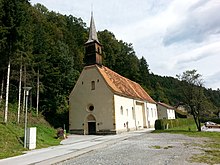Heiligenblutkirche Voitsberg
The Church of the Holy Blood in Heiligenstatt is a Roman Catholic branch church in the village of Lobming in the municipality of Voitsberg in western Styria . Their history possibly dates back to the end of the 13th century.
Location
The church stands east of the town of Voitsberg, in the village of Lobming, on the road between Voitsberg and Graz .
history
The church was reportedly built in 1293. It was first mentioned in a document in 1394, but is not considered to be entirely reliable today. Only later mentions in 1443 and 1471 are considered certain. The middle part of the building has proven to be the oldest part of today's church, underneath which remains of the wall of a Gothic choir with a five-eighth closure have been preserved.
Around 1500 and in the 17th and 18th centuries, the church was expanded and rebuilt. The church was restored between 1953 and 1957 and between 1994 and 1995. In the course of the restoration in 1994/95 there were also archaeological investigations in which the remains of an apse were uncovered.
description
The church is an elongated, late Gothic building with a baroque choir extension . The hipped roof has a turret with a pointed helmet in the west , which houses a Gothic bell cast in the 14th century. The entrance portal in the west has a barred, pointed arch stone wall, the southern church portal has a keel arch . On the outer wall there is a larger, empty wall niche which used to house a crucifixion group .
The three-bay nave has set buttresses and is spanned by a ribbed vault resting on semicircular services . The two- bay , Gothic choir is narrower than the nave and is also vaulted by a ribbed vault on round consoles . The consoles are decorated with coats of arms. The choir is separated from the nave by a narrow, low front arch . In the east there is another choir, which was probably added in the 17th century and to which the sacristy is connected. This baroque choir has two bays and is the same width as the nave. It is spanned by a groin vault resting on pillars . The wooden gallery is in the western part of the nave.
The rococo high altar dates from 1777. The black and gold pulpit was erected around 1670 and the organ in 1706. The late Gothic white marble fountain basin bears a house sign . The open confessional in the sacristy probably dates from the end of the 17th century. In the church there is a baroque crucifix from the second half of the 17th century and a representation of Maria Magdalena from the middle of the 18th century. Furthermore, two pictures from the first half of the 17th century and painted over in 1835 hang in the church, showing the Resurrection and the Last Judgment .
A stone on the sacrificial box on the church wall shows two downward striving lilies with a salamander . The lignite - foreman Johann Eder († 1970) was the character using an alchemist Scripture interpret and recognized it as an indication of Mountain Gold. Without knowing the exact location, inspired by a legend , he went looking for gold at the foot of the Rappoldkogel and found what he was looking for. He also found that the church deviates from the usual west-east orientation and is oriented precisely in the direction of the mountain, which is a good 20 km away.
literature
- Federal Monuments Office (ed.): Dehio Steiermark (excluding Graz) . 2nd Edition. Berger, Horn / Vienna 2006, ISBN 3-85028-439-5 , p. 586 .
- Gottfried Allmer: Voitsberg - portrait of a city and its surroundings-church history . Ed .: Römisch-Katholisches Stadtpfarramt Voitsberg. tape 3 . Voitsberg 2012, p. 46-52 .
Web links
Individual evidence
- ↑ a b Gottfried Allmer: Voitsberg - portrait of a city and its surroundings-church history . Ed .: Römisch-Katholisches Stadtpfarramt Voitsberg. tape 3 . Voitsberg 2012, p. 46-47 .
- ↑ a b c Ernst Lasnik : Voitsberg - portrait of a city and its surroundings . tape 1 . Municipality of Voitsberg, Voitsberg 2012, p. 220 .
- ↑ a b c d e f Federal Monuments Office (ed.): Dehio Steiermark (excluding Graz) . 2nd Edition. Berger, Horn / Vienna 2006, ISBN 3-85028-439-5 , p. 586 .
- ↑ Voitsberg parish. www.katholische-kirche-steiermark.at, accessed on February 1, 2016 (German).
- ^ Hans Eck: Mining and Mineralogy of Hirschegg and the surrounding area. In: Ernst Lasnik (Ed.): 750 years of Hirschegg. Portrait of a special western Styrian place , Hirschegg 1996, pp. 343–348.
Coordinates: 47 ° 2 ′ 18.3 " N , 15 ° 10 ′ 6.9" E
